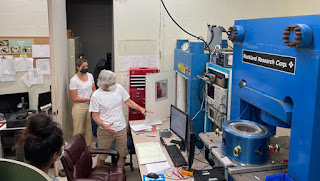 |
| Students visit Bin Chen’s high pressure mineral physics laboratory, learn from Robert Rapp. |
Planets form from disks of gas and dust that surround young stars. Previous research has shown that nearly all stars are born with such disks, and revealed hints of planet formation within them. Surveys for planets around other stars, termed “exoplanets,” have discovered that Earth-size and presumably rocky planets are common, and many stars have planets orbiting much closer to their host star than the Earth-Sun distance. But most of the steps between dust and planets are poorly understood, in part because they are obscured within the inner region of these proto-planetary disks.
The National Science Foundation (NSF) and NASA recently awarded a total of $1.3 million in three separate grants to teams of UH Mānoa scientists from the Department of Earth Sciences and Hawaiʻi Institute of Geophysics and Planetology in the School of Ocean and Earth Science and Technology (SOEST), the Institute for Astronomy (IfA), and the Information and Computer Science Department (ICS) to explore this inner realm around other stars—and our Sun—in search of the secrets to planet formation.
SOEST Earth Sciences professor Eric Gaidos, lead investigator on two of the grants, explained, “the story of planet formation is like an epic movie, where we could watch only the dramatic opening scene and the happy ending, but missed everything between, leaving us guessing about the main characters, their roles and most of the plot.”














.jpg)

